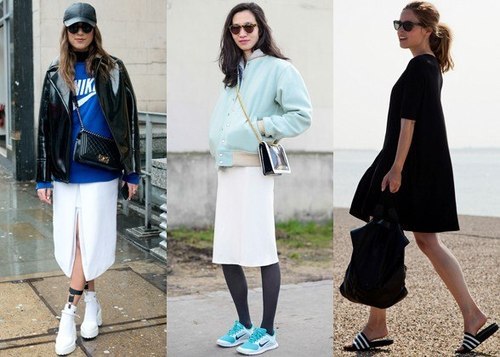From Manolo Blahniks to Birkenstocks: Are Walkable Cities Impacting Fashion Trends?
Photo: Lucky Mag
Last year, when some of the fashion blogs I followed were talking about Birkenstocks coming back in style, I laughed it off as a ridiculous fad. I would never be caught dead in shoes that belong solely for hippies and German tourists (pun intended).
Then I became a new mom in the summertime, who needed to get around her walkable neighbourhood in a comfortable shoe that could be slipped on and off easily. So I succumbed to the trend and bought a pair, and as you can guess, I have been living in them all summer. It helps to know I am totally on trend.
According to The Guardian, Birkenstock's two-strap Arizona is the "style du jour," having made an appearance in the Céline spring/summer 2013 collection in Paris.
"That silhouette was universally considered ugly," Vogue contributor Katherine Bernard told the magazine in July 2013. "But [Céline designer] Phoebe Philo's luxe reinterpretation got me thinking. It's the most comfortable sandal in the world having a stylish renaissance."
more It isn't just Birkenstocks that are hot right now. Flat walking shoes like Tevas and slip on Converse; jogging/drawstring pants; loose, dressy t-shirts, flannel, etc. All of these clothes are designed to be comfortable and practical for people who like to walk. Is this a sign that the fashion industry is embracing the walkable city? Or that more people are living in cities, thus walking (and possibly biking) more and needing clothes to fit their lifestyle?
Probably the latter. When I read through Vogue's iconic September issue, writer Sarah Mower wrote in her "Street Signs" piece:
"What can we divine from the influx of "ugly shoes" like Tevas and Birkenstocks and all their derivatives - and the wholesale shift from high heels to low? It's another blip on the radar of a bigger change: Fashion at large is readjusting grounding itself in different sensibilities - not the died fantasy of taking the limo from house to red carpet, but rather the idea of walking in the streets and riding the subway. Casual. Real."
Photo: Copenhagen Cycle Chic
More people are choosing to live in urban environments rather than car-dependent sprawl. They need clothes to match their urban lifestyle, which involves walking, biking or taking public transit to run errands, go to work and go out with friends.
This take of urban practicality is not just aimed at the style-conscious set, who can now purchase an $840 pair of studded Birkenstock-style sandals and $3000 leather jogging pants from DSquared. The Gap, legendary purveyor of denim and basics, is launching a new campaign to celebrate its role as the chosen brand for what is dubbed the norm core movement (which some view as a response to over-the-top hipster fashion - I am looking at you, dude, with the handle-bar moustache and bowl hat).
The Gap marketing campaign is dubbed "Dress Normal," and the images of celebrity artists like Lorde and Angelica Houston are accompanied by taglines such as "dress like no one's watching," "get caught wearing the same thing" and "let your actions speak louder than your clothes." According to Seth Farbman, global chief marketing officer for Gap,"'Dress Normal' is about dressing for yourself. It's about celebrating the confidence that comes by dressing how you're most comfortable."
"So many people in other countries have been brainwashed into believing that cycling is just a sport or a hobby and haven't entertained the thought that it could be a daily transport activity. Copenhageners ride in style, on normal bikes and in normal clothes. Even those who are not chic ride with an ease and elegance that borders on poetry."
Vogue UK senior fashion manager, Olivia Ferragamo, "I ride in exactly what I would wear to work, with a change of shoes and no jacket. Typically it's a dress and some flats. At the office I just add heels and a jacket." (photo: Olivia Ferragamo ©Michael Donkin)
Many argue that the move toward "normal" comfortable clothing is just another way for the fashion industry to reinvent itself. But, it is more than that. Call it "norm core" or "cycle chic," whatever it is, this trend reflects people's desire to live in a place where they can walk or bike - and look good and feel comfortable while doing it.
Scooting around in a car while wearing dress shoes and a mini skirt or a suit is no longer realistic or desirable. According to Mower:
"Fashion is an organism that senses when it needs to reboot itself - for both new customers and established older ones, either of whom might be showing dangerous signs of not finding clothes to fit their daily lives."
As our daily lives involve more walking and biking instead of driving, then it appears that Birkenstocks are here to stay.





